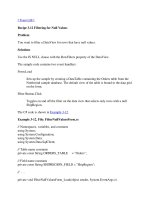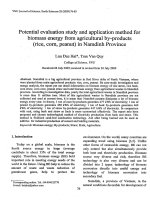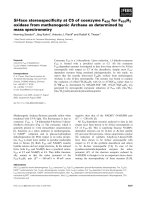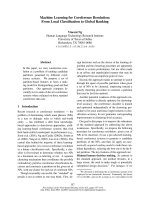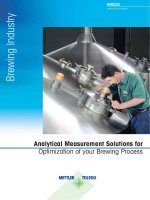Filtering for stochastic volatility from point process observation
Bạn đang xem bản rút gọn của tài liệu. Xem và tải ngay bản đầy đủ của tài liệu tại đây (1.26 MB, 10 trang )
<span class='text_page_counter'>(1)</span><div class='page_container' data-page=1>
VNU Joumal of Science, Mathematics - Physics 23 (2007) 168-177
Filtering for stochastic volatility from point process
observation
Tidarut Plienpanich1, Tran Hung Thao2 *
<i>l Schooỉ o f Maíhematics, Suranaree University o f Technology, 111 Universitỵ Avenue,</i>
<i>Muang District, Nakhon Ratchasima, 30000, Thailand </i>
<i>2Institule o f Mathematics, 18 Hoang Quoc Viet, Cau Giay, Hanoi, Vìelnam</i>
Received 15 N o ve m b e r 2 0 0 6 ; received in revised fo rm 12 Septem ber 2007
<b>Abstract. In this note we consider the ĩiltering problem for íinancial volatility that is an </b>
O m s te in -U lh e n b e c k process fro m p o in t process observation. T h is p ro b le m is investigated fo r
a M a rk o v -F e lle r process o f w h ic h the O m s te in -U lh e n b e c k process is a p a rtic u la r case.
<i>Keyyvords:</i>
and phrases: íiltering, volatility, point process. AMSC 2000: 60H10; 93E05.<b>Introduction and notations</b>
Stochastic volatility is one o f m ain objective to study o f financial m athem atics. It reílects
qualitively random effects on change o f íinancial derivatives, interest rate and other íìnancial product
prices.
M any results have been received recently for volatility estim ation by íiltering approach. Rudiger
Frcy and w . J. R unggaldier [1] studied for the case o f high ữ eq u en cy data. Frederi G. Viens [2]
considered the problem o f portíịlio optim ization under partially observed stochastic volatility. Wolfgang
J. R unggaldier [3] used íĩlterin g m ethods to sp eciíy coeíĩicients o f íìnancial m arket models.
A filtering approach w as introduced by J. C vitanic, R. L iptser and B. Rozovskii [4] to tracking
volatility from prices observed at random tim es. A íiltering problem for O m stein-U lhenbeck signal
from discrete noises was investigated by Y.Zeng and L.C .Scott [5] to applied to the micro-m ovement
o f stock prices. A lso a practical m ethod o f filtering for stochastic volatility models was given by J. R.
Strouđ, N. G. Polson and p. M uiler [6].
These authors introduced also a sequentỉal param eter estim ation in stochastic volatility models
w ith ju m p s [7]. A nd other contributions w ere given recently by A. B hatt, B. Rạịput and Jie Xiong, R.
Elliott, R. M ikulecivius and B, Rozovskii.
Filtered m ulti-factor m odels are studied by E. Platen and w . J. R unggaldier [8] by a so-called
benchm ark approach to íiltering.
<b>1. Filtering from point process observation</b>
Let (fĩ,
<i>T</i>
,<i>p</i>
) be a com plete probability space on w hich all processes are defm ed and adaptedto a íiltration
<i>(Pt, t</i>
> 0 ) that is supposed to satisíy ” usual conditions”.* CorTesponding author. E-mail: lhthao@maưi.ac.vn
</div>
<span class='text_page_counter'>(2)</span><div class='page_container' data-page=2>
<i>T. Plienpanich, T.H. Thao / VNU Journal o f Science, M alhem atics</i> - <i>Physics 23 (2007) 168-177</i> 169
For the sake o f simplicity, all stochastic processes considered here are supposed to be 1
dim ensional real processes.
We consider a íiltering problem w here the signal processes is a sem im artingale
w here
<i>zt</i>
is a square integrable<i>T t-</i>
m artingale,<i>H t</i>
is bounded<i>T t -Progressive </i>
process and £ [ s u p a<t |X S|]< oo for every
<i>t</i>
> 0,<i>Xo</i>
is a random variable such that<i>E \X o \2 <</i>
oo; the observation is given by ap oint process <i>T ị -</i> sem im artingale o f the form
w here
<i>Mt</i>
is a square integrable ^ t-m artin g a le w ith m ean 0, M o = 0 such that the íìiture<i>ơ-</i>
íìeld<i>ơ (M u - M t \u</i>
><i>t)</i>
is independent o f the past One<i>ơ (Y u, h u\ u</i>
<<i>t), h t — h ( X t )</i>
is a positive bounded<i>Tt~</i>
Progressive process such that<i>E</i>
/<i>h%ds <</i>
oo for every<i>t.</i>
Denote by
<i>T ị</i>
the ơ -alg eb ra generated by all random variables<i>YS1S < t.</i>
T hus <i>t ỵ</i> records alliníorm ation about the observation up to the tim e
<i>t.</i>
Suppose that the process
<i>u s =</i>
-7- <<i>z , M >s</i>
is<i>F 3-</i>
predictable (s <<i>t)</i>
w here < , > stands<i>ds</i>
for the quadratic variation o f
<i>Zị</i>
and<i>M t.</i>
D enote also by<i>ủ s</i>
the<i>ĩ Ỵ -</i>
predictable projection o f<i>u t .</i>
Byassum ptions imposed on
<i>z</i>
and<i>M</i>
we see that < z ,<i>M</i>
> = 0, so<i>u 3</i>
= 0.The ĩilter o f (
<i>X t</i>
) based on iníorm ation given by ( y t ) is defined as the conditional expectationThe process
<i>m t</i>
is called the innovation from the observation process<i>Yt .</i>
<i><b>Lemma 1.1. m t is a point process tỵ-m a rtin g a le and fo r any t, the f,'uture ơ-fìeld ơ (m t - m s \ t > s) </b></i>
<i>is independent o f !FỴ.</i>
<i>ProoỊ.</i>
We have by definitions (2) and (5):(
<sub>1</sub>
)
(
2
)
(3)
(4)
(5)
(
6
)
It follows from assum ption o f
<i>Mt</i>
that</div>
<span class='text_page_counter'>(3)</span><div class='page_container' data-page=3>
170 <i>T. Plienpanich, T.H. Thao / VNU Journal o f Science, M aíhemaíics</i> - <i>Physics 23 (2007) 168-177</i>
On the other hand, since for
<i>u</i>
><i>s</i>
<i>E{hu\rỴ) = E [E {K tâ )\rỴ \</i>
=
<i>E[</i>
<i>k</i><i>{K)\FỴ\,</i>
or
<i>E [ J [hu - iĩ(hu)]du\TỴ] =</i>
0,
(8)
and then
<i>E [ m t -</i> 771,1^/] - 0 , <i>t > s .</i> (9)
N ow for any
<i>s, t</i>
such that 0 <<i>s < t</i>
we consider two íam ilies<i>Ct</i>
and<i>T>t</i>
o f sets o f random variablesdeíined as fol!ows:
<i>C</i>
<i>3 1</i><i> =</i>
{sets
<i>Ca , s < a < t}</i>
where
<i>Ca</i>
= {m É — m Q ; a < a <
<i>t}</i>
<i>T>a =</i>
{sets<i>D b,0 < b < t}</i>
where<i>Db</i>
= {V/3<i>; b</i>
<<i>0 <</i>
s}.It is easy to check that
<i>c s t</i>
and<i>T>s</i>
are 7T-systems, i.e. they are closed under íin ite intersections.A lso they are independent each o f other by (9). It follows that (refer to [9]) the ơ-algebra
<i>ơ(Cs t</i>
) =<i>ơ (m t</i>
—<i>m 3, s < t)</i>
generated by<i>c , t</i>
is independent o f (7-algebra<i>ơ ( V 3)</i>
= <i>t ỵ</i> generated by<i>V ,.</i>
Thesecond assertion o f Lemma 1.1 as thus established.
We State here an im portant result by p. Bremaud on an integral representation for <i>t ỵ</i> -martingale:
L em m a 1.2.
<i>Let Rt be a </i>
<i>t ỵ</i><i>-martingale. Then there exists a </i>
<i>t ỵ</i><i>-predictable process K t such thai </i>
<i>fo r all t</i>
> 0,<i>I K 3ĩr(ha)ds <</i>
oo<i>p.a.s,</i>
(1 0)<i>J</i>
0
<i>and such that Rị has the following representation:</i>
<i>R t = R o + [ K sd m a.</i>
(11)<i>J</i>
0
R em ark . Since the innovation process
<i>m t</i>
is a <i>t ỵ</i> - m artingale so it can represented byrriỊ = m o + /
<i>K sd m sì</i>
(1 2)<i>J</i>
0
where
<i>K t</i>
is som e <i>t ỵ</i> - predictable process satisíying (1 0). It is know n from [1 0] that<i>K t</i>
is o f theform
<i>K t = ir{ h t)-x\K{Xt- h t) - n { X t- ) iĩ( h t) + ủ t]}</i>
and since ú( = 0 w e have
T h eo rem 1.1.
<i>Thefìltering equation fo r the filtering problem (1)- (2) is given by:</i>
<i>n (X t) = Tĩ(X0)</i>
+<i>[ iĩ(H a) d s + </i>
<i>Ị </i>
<i>n ~ l (h3)[n (X s- h 3) - Tr(Xa-)ir(h s)]dms.</i>
(13)<i>J</i>
0<i>J</i>
0</div>
<span class='text_page_counter'>(4)</span><div class='page_container' data-page=4>
<i>T. Plienpanich, T.H. Thao</i> / <i>VNU Journal o f Science, Malhematics - Physics 23 (2007) 168-177</i> 171
R e m a rk . If the observation is given by a Standard Poisson process
<i>Yị</i>
then the filtering equation takesthe follow ing form
<i>7r(X f) = n (X 0) + </i>
<i>Ị</i>
<i>7T(Hs)ds+ [ n~l (h3)X3-[n(h3) - l]dma, </i>
(14)
<i>J</i>
0
<i>J</i>0
w here
<i>m t — Yt — t.</i>
Q u a s i-n ite rin g . There is som e inconvenience in application o f (13) because the appearance o f the
factor[7r(/iJ)]_1. To avoid this đifficulty we introduce the unnorm alized condỉtional íĩltering or quasi-
n iterin g in other term.
As we know in the method o f reference probability, the probability
<i>p</i>
actuaily govem ing thestatistics o f the observation
<i>Yị</i>
is obtained from a probability <5 by an absolutely continuous change<i>Q —* p .</i>
We assum e that<i>Q</i>
is the reference probability such that<i>Y</i>
is a (<i>Q</i>
,<i>!Ft)-</i>
Poisson process o fintensity 1, w here
<i>T t</i>
=<i>T Ỵ</i>
V-^TO-D enoting for every
<i>t ></i>
0 by<i>Pt</i>
and<i>Qt</i>
the restrictions o f<i>p</i>
and<i>Q</i>
respectively to (Í2,<i>F t)</i>
wehave
<i>p t «</i>
<i> Qt-</i>
It is know n that the corresponding Radon-Nykodym đerivative is the unique solutiono f a D oleans-D ade equation:
<i>Lị = \ + [* L s - ( h s — l) d M a,</i>
(15)
<i>J</i>
0
vvhere
<i>ht</i>
and<i>Mi</i>
are given in (2).T he explicit solution o f (15) is
<i>L t = </i>
<i>= n 0<a<thsA Y 3exp [</i>
(1 -<i>h t )ds.</i>
(16)<i>dQt </i>
<i>J</i>
0Let
<i>z t</i>
be a real valued and bounded process adapted to<i>T i,</i>
then for every history<i>Qt</i>
such thatí > 0 we have a Bayes íòrm ula
<i>p , , ( 7 \c \ - EQ(ZtLt\Ợt) </i>
<i>.</i>
.
<i>Bp(Z,</i>
Ịft) =
(17)
vvhere <i>Ep{.\Qt)</i> and <i>Eọi.ịGt)</i> are conditional expectations under probabilities <i>p</i> and <i>Q</i> respectively.
D cfínition. T he process
<i>ơ { X t</i>
) defined by<i>a ( X t) = E Q ( L tX t \ T t ) </i> (18)
is call the optim al q uasi-íilter (or quasi-filter) o f
<i>x t</i>
based on data<i>T ị.</i>
It is in fact an unnormalizedĩilte r o f <i>x t .</i>
R e m a rk s.
(i) If under the probability
<i>Q, Yt</i>
is a Standard Poisson process ( i.e o f intensity 1) and theprocess
<i>Ht = Yt - t is</i>
then a<i>(Pt,</i>
Q )-m artingale.(ii) We have by consequence o f the definition
<i>< x t)</i>
=<i>(19)</i>
where 1 stands for íunction identifíed to for every
<i>t: l( t) = 1.</i>
R eplacing 7r(.) by its expression given by (19) w e can revvrite the ĩiltering equation (14) as an
</div>
<span class='text_page_counter'>(5)</span><div class='page_container' data-page=5>
172 <i>T. Pỉienpanich, T.H. Thao / VNU Journal o f Science, Mathematics</i> - <i>Physics 23 (2007) 168-177</i>
<b>Theorem 1.2. </b>
<i>The assumptions are those prevailing in Theorem 1.1. Moreover, assume thai Zt and </i><i>Mị have no common jumps. Then the quasi-fỉlter ơ ( X t) satisfies th e/o ỉlo m n g equation</i>
<i>ơ {X t) = ơ ( X 0)</i>
+<i>Ị </i>
<i>ơ (H a)ds + </i>
<i>Ị </i>
<i>[ơ(X 3- h a) - ơ ( X s-)]d n 3ì</i>
(2 0)<i>J</i>
0<i>J</i>
0<i>where</i>
<i>nt = Yt - t .</i>
(21)Proof. Suppose we have (13) already:
<i>ir (X t ) = n{Xữ) + Jq H { X a)ds + Ịq n ~ l ( h a)'Ỵad m a</i> ( 1 3 ) ’
where 7, =
<i>n ( X 3- h3) - n ( X s- ) n ( h 3)</i>
and<i>m 3 — Y3 - f*Tr(hs)ds.</i>
By deíinition <i>ơ ( X</i>t) = <i>ĩ r ( L t ) n ( X t).</i> A p plying a íorm ula o f integration by part we get
<i>ir(L t)n (X t) = tĩ(Xq)</i>
+<i>[ n ( X 3)n (H 3)d s + </i>
<i>Ị</i>
7r( L í - )7 sá m s<i>J</i>
0
<i>J</i>0
<i>+ [ n ( X a- ) n ( L 3-){Tĩ(ha) - l]dn 3</i>
+ [7r ( L ) ,7r ( X ) ]t (22)<i>J</i>
0
w here
<i>n t = Yt - t</i>
and [.,.] stands for the quadratic variation.Because 7r(X o) =
<i>ơ(X o)</i>
and there are at most countably many points where<i>n ( L t- )</i>
ỹỂ 7r(L<)so
<i>[ </i>
<i>n ( L a-)ir(H s)ds = </i>
<i>Ị </i>
<i>ir{L,)-K(H3)ds = </i>
<i>Ị </i>
<i>ơ (H s)ds.</i>
<i>J 0 </i> <i>J</i>
0
<i>J</i>0
On the other hand we have
<b>[7r ( L ) , i r ( * ) ] t = E</b> <b>= </b>
<i>- l]dY,.</i>
<b>(23)</b>0
<i><?<t </i>
<i>Jữ</i>
Then
<i>n (L t)ir(X t)</i>
=<i>ơ (X t) = <r{X0) + [ a {H 3)ds+</i>
<i>J</i>
0+
<i>[ n ( L a- ) [ n { X 3- h a) - TT(Xs)ir(hs)]dn3 </i>
<i>J</i>
0<i>+ [ n { L 3- ) n ( X a- ) [ n ( h s) - l] d n s </i>
<i>J</i>
0=
<i>a { X 0)</i>
+ r<i>ơ (H a)ds</i>
+<i>r [ ơ { X ,- h 9) - ơ ( X ,- ) ] d n , .</i>
(24)<i>J</i>
0
<i>J</i>
0
</div>
<span class='text_page_counter'>(6)</span><div class='page_container' data-page=6>
<i>T. Plienpanich, T.H. Thao / VNU Joum al o f Science, Mathematics - Physìcs 23 (2007) 168-177</i> 173
2. F ilte rin g fo r a F ellerian system
Suppose that
<i>Xt</i>
is a M arkov process taking values in a com pact separable H ausdorff space<i>s </i>
and that the semigroup <i>( P t , </i>
<i>t</i>
> 0) associated with the transition probability <i>P ị ( x , E ) </i>is a Fellersem igroup, that is
<i>P t f ( x ) = Ị P t{ x ,d y )f(y ),</i>
(25)<i>J</i>
0maps
<i>C ( S</i>
) into itselí for all<i>t</i>
> 0 satisfieslim
<i>p tf{ x ) = f ( x ) ,</i>
(26)<i>€</i>
uniíorm ly in
<i>s</i>
for all/ €
<i>C(S),</i>
w here C ( S ) is the space o f all real continuous íunction over<i>s. </i>
A ssum e that the observation
<i>Yị</i>
is a Poisson process o f intensity<i>hị</i>
=<i>h ( x t)</i>
6<i>C {S).</i>
A s bịre the filter
<i>nt</i>
is dìned as:<i>n ư ) = x ( f ( Xt ) )</i>
:=
<i>E \ f ( X t)\rỴ) .</i>
(27)
A lso w e have
<i>ơ t ( f )</i> := <i>c ( f ( X t)) = E Q[Lt f ( X t ) \ ? Ỵ ] t</i> (28)
whcre the probability <i>Q</i> and the likelihood ratio are defined as in subsection 1.2.
D enote by
<i>TTĩt</i>
the innovation process o f<i>Yt',</i>
<i>at{f)</i>
:=
<i>= EQ[Ltf ( X t)\rỴ)t</i>
1 the likelihood ratio are defined as in subsect
ìovation process o f
<i>Yt:</i>
<i>m t := Yt — [ ĩr3(h)ds = Yt - [ Ơ3[^lds.</i>
<i>J</i>
0<i>J</i>
0 ơ , ( l )(29)
<i>J</i>
0T he following results are given in [8]:
T h eo rem 2.1
<i>[Fìltering equationfor Fellerprocess with pointprocess observation] I f A is in/ìnitesimal </i>
<i>generor o f the semigroup p t o f the signalprocess, then the optimal/ilter</i>
7rt ( / ) =<i>satisýìes</i>
<i>the two following equations provided</i>
7Ts (/i)<i>Ỷ</i>
0 <i>O.S. </i><i>ắ)</i>
<i>M f )</i>
= 7ro ( / ) + /<i>na( A f) d s +</i>
<i>J 0</i>
<i>+ [ </i>
<i>- ira-{f)Tra{h)]dm3 , / e Cb{S), </i>
(30)
<i>J 0</i>
<i>b)</i>
<i>*tư) = *o(Ptf)+ Ir Tĩal{h)[ira-(hPt-sf)</i>
<i>J</i>
0<i>—7TS- (Pt-sf)Tra(h)]dma J 6 Cb(S). </i>
(31)
T h eo rem 2.2 [Q u a si-fílte rin g e q u atio n fo r F e lle r process w ith p o in t process o b serv atio n ].
<i>The</i>
<i>quasi-fìlter ơt satisfies the two following equations:</i>
<i>a)</i>
<i>ơ tU )</i>
=<i>ơ o ự ) + f ơ g (A f)d s</i>
+<i>f [ơ9- ( h f ) - ơa- ( f ) ] d m a , f</i>
€ C6(S ),<i>J</i>
0<i>J</i>
0</div>
<span class='text_page_counter'>(7)</span><div class='page_container' data-page=7>
174 <i>T. Plienpanich, T.tì. Thao / VNU Journaỉ o f Science, M aihematics</i> - <i>Physics 23 (2007) ỉ 68-ỉ 77</i>
<i>b)</i>
<i>M ĩ ) = M P t f</i>
) +<i>í </i>
<i>[ơ„-{hPt-3f ) - ơs- ( P t - 3f) ] d m a f</i>
G<i>Cb(S ).</i>
(33)<i>J</i>
0
<b>3. Ornstein- Ulhenbeck process and iĩnancial nitering</b>
We recall in this Section some facts on O m stein- U lhenbeck and show how to use it to our
íiltering problem s. This process is o f importance in studies in fmance. It has various ’good properties’
to describe m any elem ents in íinancial models as that o f interest rate ( Vacisek, Ho-Lee, Hull-W hite,
etc.) or stochastic volatility o f asset pricing.
Let
<i>X =</i>
(<i>X t , t</i>
> 0) be a sto ch astic process w ith in itial value Xo o f Standard norm al distributed:<i>Xo</i>
€ ^ ( 0 , 1 ) .<i>3.1. Dẹfỉnition.</i>
If<i>(Xt)</i>
is a G aussian process w itha) mean
<i>E X t</i>
= 0 , Ví > 0b) C ovariance íiinction
<i>R (s, t)</i>
=<i>E ( X 3X t) =</i>
7 e x p ( - a | í - s |) ,<i>s, t ></i>
0; Q, 7 6 R + , (34)then
<i>x t</i>
is called an O m stein-U lhenbeck.It follow s from this definition that (
<i>x</i>
t ) is a stationary process in wide-sense. It is also astationary process in strict sense since its density o f the transition probability is given by
1
<i>Ị </i>
<i>(y — x e~ 2a^ ~ 3^)2</i>
1
<i>( y - x e - 2aV - s>)2 \</i>
that depends only on (í - s ), w here 7 is some positive constant.
(35)
<i>3.2. Stochastic Langevin equation.</i>
An O m stein-U lhenbeck (X f) can be dìned also as (he uniquesolution o f the form
<i>d X t</i>
=<i>- a X t d t +</i>
7<i>dW t</i>
, X o ~ 7 ^ ( 0 ,1 ) , (36)w here
<i>a ></i>
0 and 7 are constants.T he explicit form o f this solution is
and its expectation, variance and covariance are given by
'í
<i>EX, = e~at</i>
<i>Vt</i>
: =
<i>Var(Xt) = ị -</i>
,
72
w here is denoted by
<i>/3</i>
in (34)</div>
<span class='text_page_counter'>(8)</span><div class='page_container' data-page=8>
<i>T. Plienpanich, T.H. Thao</i> / <i>VNU Journal oỊScience, Mathemalics</i> - <i>Physics 23 (2007) 168-177</i> 175
<i>3.3. Ornstein - ưlhenbeck process as a Feỉỉer process.</i>
C onsider a Standard G aussian measure on<i>R</i>
It is known that an O m tein - U lhenbeck process (
<i>X t</i>
) is a M arkov process and its sem igroup isdefined by a fam ily (
<i>pt , t ></i>
0) o f operations on bounded Borelian fi)nctions / :then
<i>x t</i>
is really a Feller process and the fam ily (<i>P t , t ></i>
0) is called an O m stein- U lhenbeck sem igroup.<i>3.4. Filtering fo r Ornstein-Uỉhenbeck process fro m point process observation.</i>
We w ill apply resultso f Section II to the following íiltering problem:
• Signal process: An O m stein-U lhenbeck process
<i>x t</i>
that is solution o f the equation (36).• O bservation process: A point process
<i>N t</i>
o f intensity<i>xt </i>
<i>></i>
0.So the signal and observation processes (X t,
<i>N t)</i>
can be expressed in the formw here a ,
<b>7</b>
> 0,
<i>xt</i>
is a ^ t-a d a p te d process,<i>M t</i>
is a point process m artỉngale independent o f<i>Wt. </i>
Denote by
<i>p ị*</i>
the ơ -algebra o f observation that is generated by (<i>N , , s < t)</i>
The íĩlter o f (
<i>x</i>
t ) based on data given by<i>(rỊ* )</i>
is denoted now by<i>Xt'.</i>
and
<i>d m t — dYị — Xtdt.</i>
Since the semigroup
<i>(Pt , t ></i>
0) for<i>X t</i>
is defm ed by (37), the iníìnitesỉm al operator<i>A t</i>
is given(37)
It is obvious that
<i>v}™(ptỉ)(x)</i>
=
<i>f ( x)y</i>
(38)<i>d X t = —a X ịd t</i>
+ n<i>fdWt</i>
, X o ~ A T (0,1), (39)<i>dN t — Xịdt</i>
+<i>M ị,</i>
(40)<i>Xt</i>
=
<i>v t ( X ) </i>
<i>= </i>
<i>E { X tự Ỵ )</i>
and also
<i>M f ) = fC * t) = E ự ( X t ) \ r Ỵ )</i>
, / 6<i>Cb(R ).</i>
T he innovation process <i>r r i ị </i> is given by
(41)
by
<i>M Ị</i>
= Ịim<i>j { P t f - ỉ ) = - a x f ( x )</i>
+ ^ -7<i>2ỉ" { x ) .</i>
(42)On the other hand,
<i>p tf</i>
can be expressed under th e form:(4 3)
</div>
<span class='text_page_counter'>(9)</span><div class='page_container' data-page=9>
176 <i>T. Plienpanich, T.tì. Thao</i> / <i>VNU Journal o f Science, Mathematics - Physics 23 (2007) ỉ 68-177</i>
<b>Theorem 3.1. </b>
<i>a)</i><i>Mf) = Mf) + Ị*n,[-aXf'(X) + £-f"(X))ds</i>
+
<i>[</i>
(A)[7T ,-(A /) - 7rs_ ( / )7rs (A)](dYs - 7Ts (À )ds), (44)<i>J</i>
0<i>b)</i>
7Tf ( / ) = <i>M p t f ) + í </i> <i>-</i> 7rs_ ( P t _ a/)7Ts (A )][cirs - 7T,(A)đa], (45)
<i>J</i>
0
<i>yvhere Pị is given by (43).</i>
T h e o re m 3.2.
<i>The quasi-fìlter ơ t ( f ) fo r the fìltering (39)- (40) is given by One o f two following </i>
<i>equations:</i>
<i>a)</i>
<i>Mf) = C</i>
<i>JỒ{Ị) + Ị \ a[-aXỊ'{X) + ịỉ"{X)\ds</i>
+ <i>f \ a a. ( X f ) -</i> <7s- ( / ) ] Ị d F s - 7T3(A )d S], (4 6)
<i>J</i>
0
<i>b) ơ t ự ) = (TO(Ptf) + f \ a a-(X P t. af ) - ơa- ( Pt - s f ) ] [ d Y3 - n a(X)ds}.</i>
<i>J</i>
0T he fisrt author was supported by the Royal G olden Jubilee Ph.D Program o f Thailand (TRF).
R e m a rk s .
(i) T he above results can be applied also to term structure models for interest rates, w here the
rate is expressed as an O rstein-ư lhenbeck process and the observation is given by a point process o f
form
<i>Nt = 1 h ( S s)ds + M t ,</i>
0 <<i>t < T,</i>
<i>J</i>
0
w here
<i>St</i>
is the a process observed stock prices the models for Vacisek, H o-Lee, H ull-W hite ... can beincluded in this context.
(ii) T he assum ption that the volatility o f asset pricing is o f form o f an O m stein-ưlhenbeck
process is quite ửeq u en tly met in various íinancial models. So above results can give another approach
to estim ate this volatility.
A ck n o w led g em en ts. T his paper is based on the talk given at the C onference on M athem atics, Me-
chanics, and Inform atics, Hanoi, 7/10/2006, on the occasion o f 50th A nniversary o f D epartm ent o f
M athem atics, M echanics and Iníorm atics, Vietnam N ational University, Hanoi.
<b>Reĩerences</b>
[ 1 ] R. Frey, W.J. Runggaldier, A Nonlinear Filtering Apptoach to Volatility Estimation wiứi a View Towards High Frequency
Data, <i>International Journal o f Theoretical and Applied Finance</i> 4 (2001) 199.
[2 ] F.G. Viens, <i>Porựịlio Opíimừation Under Partìally Observed Stochastic Volatility,</i> Preprint, Dept o f Statistics and Dept.
o f Math., Perdue University, West Lafaycltc, u s (2000).
</div>
<span class='text_page_counter'>(10)</span><div class='page_container' data-page=10>
<i>T. Plienpanich, T.H. Thao / VNU Journaỉ o f Science, Mathematics</i> - <i>Physics 23 (2007) 168-177</i> 177
[4] J. Cvitanic, R. Liptser, B. Rozovskii B, A Filtering Approach to Tracking Volatility ííom Prices Observed at Random
Times, <i>The Annaỉs oỊApplied Probabilỉty,</i> vol. 16, no. 3 (2006).
[5] Y. Zeng, L .c . Scott, <i>Bayes Estimation Via Filtering Equation fo r O-U Process with Discrete Noises: Application to </i>
<i>the Micro-Movements o f Stock Prices, Stochastic Theory and Control</i> (Bozenna Pasik-Duncan Ed.), Lecture Notes in
Control and Iníormation Sciences, Springer, (2002) 533.
[6] J.R. Sưoud, N.G. Polson N.G, p. Maller, Practical Filtering for Stochastic Volatiiity Mcxiels, <i>State Space and Unobserved </i>
<i>Components Models</i> (Harvey, Koopmans and Shephard, Eds.) (2004) 236.
[7] M. Johannes, N.G. Polson, J. Stroud, <i>Nonỉinear Filtering o f Stochastic Dijferential Equations with Jumpst</i> Working
paper, Univ. o f Columbia NY, Univ. o f Chicago and Univ. o f Pennsylvania, Philadelphia (2002).
[8] E. Platen, W.J. Runggaldier, A Benchmark Approach to Filtering in Finance, <i>Financial Engineering and Japanese </i>
<i>markets</i>, vol. 11, no. I (2005) 79.
[9] o . Kallenberg, <i>Foundation o f Modern Probabiỉity,</i> Springer, 2002.
</div>
<!--links-->
